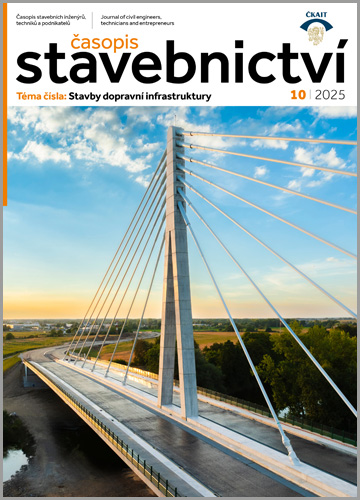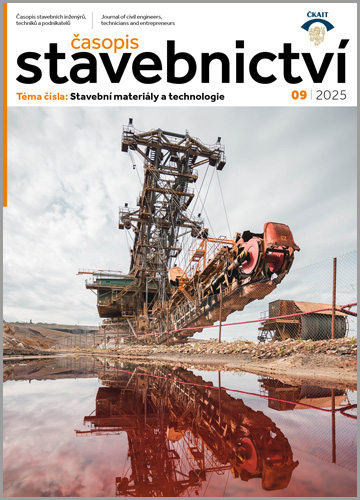TOB 5/2015
Architecture and Energy Savings
Kuwait Towers – Development and Renov
Peter Černo
The Project will be a high-profile attraction in the Arabian Gulf, with its finely coordinated interplay of extraordinary existing buildings, additional new modern architecture, structural poetry and trendsetting form of education and entertainment.
Projection, Theory, Surveys
Comparison of building energy simulation with a real measurements
Libor Šteffek, Jiří Kalánek, Milan Ostrý
Increasing public interest in energy-efficient buildings requires an understanding of the thermal, acoustic, and lighting elements of buildings. Various computer simulations are used to test buildings under different climatic and operating conditions. These simulations are very useful in verifying a design’s parameters, allowing for a project’s modification before construction even begins.
Only long-term measurements in real structures, however, can prove how virtual calculations reflect a building’s actual status. Structural heat storage capacity is a very important issue that can decrease heating and cooling costs when combined with the strategic geographic placement of a given building.
This article thus compares the results from energy simulations with actual measured data from the yearlong monitoring of energy consumption in a passive house.
Heat loss through a slab-on-ground floor: reduction of a refference 3D model to an equivalent 2D model
Zdenko Malík, Pavel Kopecký
Heat loss through a floor on ground has a significant effect on building’s total heating energy demand. Nowadays numerical methods exist, which can accurately compute the floor on ground heat loses during a timespan. As a large three dimensional area is to be evaluated, such methods tend to be very time-demanding. This article therefore aims to verify, if the primary three-dimensional problem can be substituted by an equivalent two-dimensional geometry with modified building width. The change of three-dimensional geometry of the computed area to the equivalent two-dimensional geometry is being tested for both steady and transient thermal state. For different sizes and geometries of the floors numerical heat loss simulations using 3D FEM have been conducted. A comparison between the reference heat flux based on a three-imensional model and the heat flux given by a two-dimensional model show, that from some value of the equivalent width (B’/2>1,75m) are both heat flux courses comparable. The deviation was within the range of computational model’s uncertainties caused by the uncertainty of input parameters.
Coefficient of thermal conductivity for the boards HOFAFEST UD – experimental results
Petr Kučera, Jaroslav Řehánek
Experimental results of coefficient of thermal conductivity for the boards HOFAFEST UD values with respekt to the mass density, mass humidity and temperature are shown in this article. HOFAFEST UD are the wood chip boards.hydrofobic paraffin.
Energy Savings, Economy, Efficiency
Design of an optimum thermal protection of buildings with respect to the cost effectiveness
Jana Bendžalová
In most cases of building renovation, the fulfilment of minimum requirement for the internal surface temperature is already met by the design of building thermal protection at the level of requirements for the maximum values for thermal transmittance of building constructions according to STN 730540-2:2012. More strict requirements, design of thicker thermal insulation or implementation of mening structures with better thermal properties have a single goal – to ensure the energy savings. The concepts of evaluation of costs optimality and costs effectiveness of recommendations for improvement of energy performance of buildings are introduced in current legislation and in the technical standard STN EN 15459.
The differences between the costs optimality and cost effectiveness for improvement of thermal protection of buildings are described in this article.
Marginals for the Chinese economy
Milan Cikánek
Current state of the Chinese economy – GDP growth slow down, currency depreciation, supporting the export, the impact of events on further economic development.
Laws, Technical Regulations, Standards and Recommendations
Large scale fire test of walls’ insulations according to ISO 13785- 2 and its follow up for the achal ČSN 73 0810 requirements
Pavel Rydlo
The revised ČSN 73 0810 [1] that clarifies and complements further principal and subsequent fire standards of 73 08xx series, valid already from April 2009, and its amendment Z1 from May 2012 respectively. Particularly in the area of external thermal insulation composite systems ETICS (External Thermal Insulatin Composite System), compared to the previous, was amended and clarified. In terms of increased protection of these systems against spreading fire introduces for buildings of height above 12m several solution approaches. Without confirmation by a fire test, it is possible to use above window and other openings within these systems with a foam polysthyrene, a 500mm thick mineral insulation belt. Another option is to propose a different solution that was verified from the aspect of spreading the fire by a test in accordance with ISO 13785-1:2002 [2] or ISO 13785-2:2002 [3].
Materials and Products for Buildings
Control garage gate and doors remotely using smart phones
Realization and Quality of Buildings, their use
Influence of bearing steel on equivalent thermal conductivity coefficient of thermal insulation parts of bearing elements Isokorb
Peter Buday, Rastislav Ingeli
Actual trends in building development show continuous improvement in a field of material basis, basis of construction design of particular building parts as well as their entity. Presented paper deals with specific problems of structural design of balcony slab. For the balcony the thermal barrier was used – thermal insulation with reinforcement in comparison with „ classical solution” (whole balcony slab is thermally insulated). In addition to specifications of structural solution, it points out problematics of heat lost increment and possibility of fulfilling the hygienic criterion particular 3D detail following the thermal insulation and minimization of energy intensity of building (influence of envelope). Using of available methods, we are trying to quantify the problem even with connection of thermal parameters of building’s envelope.
Energy-savings Buildings
The draft of thermo technical solution for historici building construction of Concha
Veronika Bartošová, Marián Vertaľ
Skating Pavilion in Kosice is used as a social space for the general public since the early 20th century. The paper deals with a number of alternative solutions to the thermal protection of the historic building structure with extreme subtlety and complex geometric shape – shell structure of concha. It presents the results of different variants of thermal technical design to meet the hygiene criteria using the simulations in non-stationary boundary conditions.
Education – Conferences – Reviews
Buildings‘ insulation in a conference mirror – part VI – foam polystyrene
František Vörös
In a continuation about the findings from the conferences, I will focus this times on the EPS insulations – information from the conference Fire safety 2015 that took place from 9th to 10th
September 2015 in Ostrava, will be presented. Further to that, Masterclass EUMEPS – flat roofs
that took place from 21st to 22nd September in Prague and the conference Waste generation prevention
that took place from 6th to 7th October, 2015 in Prague.
Info Service
Foreign magazines – selected topics
Information of CZB
Members meeting CZB CR34













